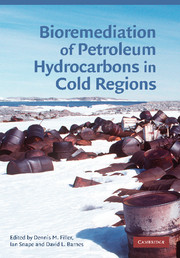Book contents
- Frontmatter
- Contents
- List of contributors
- Preface
- Glossary
- 1 Contamination, regulation, and remediation: an introduction to bioremediation of petroleum hydrocarbons in cold regions
- 2 Freezing and frozen soils
- 3 Movement of petroleum through freezing and frozen soils
- 4 Hydrocarbon-degrading bacteria in contaminated cold soils
- 5 Temperature effects on biodegradation of petroleum contaminants in cold soils
- 6 Analytical methods for petroleum in cold region soils
- 7 Treatability studies: microcosms, mesocosms, and field trials
- 8 Nutrient requirements for bioremediation
- 9 Landfarming
- 10 Thermally enhanced bioremediation and integrated systems
- 11 Emerging technologies
- References
- Index
4 - Hydrocarbon-degrading bacteria in contaminated cold soils
Published online by Cambridge University Press: 22 August 2009
- Frontmatter
- Contents
- List of contributors
- Preface
- Glossary
- 1 Contamination, regulation, and remediation: an introduction to bioremediation of petroleum hydrocarbons in cold regions
- 2 Freezing and frozen soils
- 3 Movement of petroleum through freezing and frozen soils
- 4 Hydrocarbon-degrading bacteria in contaminated cold soils
- 5 Temperature effects on biodegradation of petroleum contaminants in cold soils
- 6 Analytical methods for petroleum in cold region soils
- 7 Treatability studies: microcosms, mesocosms, and field trials
- 8 Nutrient requirements for bioremediation
- 9 Landfarming
- 10 Thermally enhanced bioremediation and integrated systems
- 11 Emerging technologies
- References
- Index
Summary
Introduction
Bioremediation is a viable option for the cleanup of hydrocarbon-contaminated soils. Although this technology has proven effective for various temperate soils, extrapolation to cold soils is hindered by the lack of information about specific microbes, genes, and enzymes involved in hydrocarbon biodegradation in cold soils. These environments present multiple challenges to bioremediation besides low temperature and concomitantly lower enzymatic reaction rates: for example, cold soils are often poor in nutrients, low in available water, and may exhibit extremes of pH and salinity. Also in such environments the physical nature of the contaminant(s) is affected, with increased viscosity of liquid hydrocarbons and reduced volatilization of toxic, low molecular weight hydrocarbons. Despite these constraints, the biodegradation of many of the components of petroleum hydrocarbons by indigenous cold-adapted microbial populations has been observed at low temperatures in hydrocarbon-contaminated soils (e.g. Braddock et al. 1997; Aislabie et al. 1998; Margesin and Schinner 1998; Whyte et al. 1999a; Mohn and Stewart 2000). However, because hydrocarbons tend to persist in polar soils, there are obvious limitations to the activity of the indigenous microbes in situ.
In this chapter we review the literature describing hydrocarbon-degrading bacteria indigenous to cold soils, with a focus on polar soils. We discuss their adaptations to environmental parameters that challenge their activity in situ, including cold and fluctuating temperatures, limited nutrient availability, extremes in pH and salinity, and desiccation. We provide recommendations for methods to determine whether a soil contains the appropriate microbial community for applying bioremediation.
- Type
- Chapter
- Information
- Bioremediation of Petroleum Hydrocarbons in Cold Regions , pp. 69 - 83Publisher: Cambridge University PressPrint publication year: 2008
- 10
- Cited by



